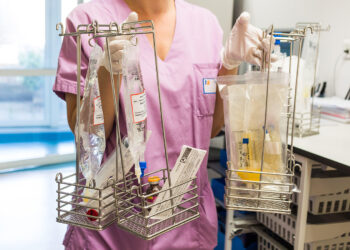[ad_1]

Light micrograph of a cervical smear, or pap smear, from someone with bacterial vaginosis
DR. Y. BOUSSOUGAN/CNRI/SCIENCE PHOTO LIBRARY
Women with bacterial vaginosis, a recurrent condition that raises the risk of pregnancy complications, could benefit from their male sexual partners being treated with antibiotics, according to a trial that found this nearly halved the risk of symptoms returning.
“Treating male partners made the most significant inroad into improving recurrence rates in women that we have seen for decades,” says Catriona Bradshaw at Monash University in Melbourne, Australia, who led the work.
Bacterial vaginosis (BV) affects around a quarter of women of reproductive age worldwide. It occurs when “harmful” bacteria overgrow in the vagina, causing vaginal discharge to turn greyish-white and smell fishy, with potentially serious complications. “It increases a woman’s risk of acquiring a broad range of sexually transmitted infections, like HIV, and complications in pregnancy, such as premature birth and miscarriage,” says Bradshaw.
Doctors usually treat the condition using antibiotics in the form of pills or a cream that can be applied inside the vagina, but symptoms often recur because having sex seems to reintroduce problematic bacteria, says Bradshaw. “One in two women will get their BV back within three to six months of the recommended treatment regimen,” says Bradshaw.
To address this, Bradshaw and her colleagues recruited 137 monogamous women in Australia with bacterial vaginosis, along with their male partners. All of the women took standard antibiotics for a week, while around half of their partners were given oral antibiotics and told to apply an antibiotic cream to the penis over the same period. The remaining men received no treatment. None of the participants was transgender.
Three months later, 63 per cent of the women whose partners weren’t treated had recurring symptoms, while just 35 per cent of the women with partners who received antibiotics experienced a recurrence. “It’s definitely a sizable effect that makes it a worthwhile intervention for this group of women,” says Janneke van de Wijgert at Utrecht University in the Netherlands.
“I see a ton of women that have issues with ongoing BV and, absolutely, I’ll be applying this new information to my own clinical practice,” says Christina Muzny at the University of Alabama at Birmingham.
The team didn’t track all the participants over the long term, but some got back in touch years later to say they remained free of symptoms. “In the last week, I’ve talked to someone who’s been clear of BV for two years since they participated – and these women were highly recurrent before the trial,” says Lenka Vodstrcil at Monash University.
However, the approach won’t work for women with casual sexual partners, where it may be difficult to get them to adhere to taking antibiotics, says van de Wijgert. Even in monogamous relationships, men may not always be willing to take antibiotics, she says. “We’ve seen this with condom use, which also reduces BV recurrence – it can be really difficult for women to get their male partners to use condoms.”
Topics:
[ad_2]
Source link : https://www.newscientist.com/article/2470994-men-taking-antibiotics-could-cut-rates-of-bacterial-vaginosis-in-women/?utm_campaign=RSS%7CNSNS&utm_source=NSNS&utm_medium=RSS&utm_content=home
Author :
Publish date : 2025-03-05 22:00:00
Copyright for syndicated content belongs to the linked Source.














